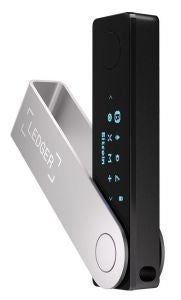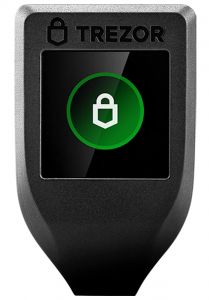What is a cold wallet?
Firstly a crypto wallet doesn’t actually store crypto. That always remains securely on the blockchain. Rather, crypto wallets hold the keys to that crypto. Whoever has the keys, has access to the crypto, so it’s pretty important to keep them secure.
When it comes to storing your keys in a crypto wallet, you have several options.
A cold wallet is (usually) a physical device (also known as a hardware wallet) that acts as your crypto wallet. The key component is that these are not connected to the internet, which makes them difficult to hack and extra secure.
This differs from a hot wallet, which stores your crypto keys online and is thus more susceptible to hacks. Hot storage options include when you leave your keys on an exchange or on an app downloaded to your phone.
How does a cold wallet work?
In general, cold wallets store your keys offline, in order to minimise the risk of hacks. The most common method of cold wallet storage is through a hardware wallet, which we’ll look at below. It’s worth noting that there are some other cold storage options. After all, a cold wallet is any form of storing your crypto keys offline. That could be as simple as written on a piece of paper or stored on a regular USB (though these methods aren’t suggested).
Hardware wallets
Hardware wallets store your private keys on a physical device, which you have password protected. This means no one can access your keys unless they have the physical device in their hands, and can guess your passcode. Furthermore, unless trading, cold wallets are offline, making them near impossible to hack remotely.
This differs from a hot wallet, which stores your keys online. This makes it susceptible to hackers who can gain access and steal your keys and, ultimately, your crypto.
→Related article: Custodial vs. Non-Custodial Crypto Wallets
Where to buy Bitcoin in NZ
The display order does not reflect any ranking or rating by Canstar. The table does not include all providers in the market.
| Provider | Fiat Currencies | Bitcoin | Other Currencies | Est. |
| Easy Crypto | NZD, AUD | Yes | 100+ | 2018 |
| Independent Reserve | NZD, AUD, USA | Yes | 24 | 2013 |
| Kiwi Coin | NZD | Yes | No | 2014 |
| Swyftx | NZD, AUD | Yes | 228 | 2017 |
This information is not an endorsement by Canstar of cryptocurrency or any specific provider. Canstar is providing factual information supplied by providers. Cryptocurrencies are speculative, complex and involve significant risks. Canstar is not providing a recommendation for your individual circumstances or in relation to any particular product or provider.
What if you lose the device? Or worse, it’s stolen?
If access to all your crypto is stored on a small USB-like device, what happens if you lose it?
Well, it’s not the end of the world! As mentioned above, you can’t gain access unless you know the pin to the device. So unless it’s stolen by a personal friend that knows your password – but don’t share your passwords with anyone!) – there’s not too much reason to worry. And if the thief enters the wrong pin multiple times – the amount depends on the model – the device factory resets itself. So there’ll no longer be anything on the device for them to steal!
But don’t panic. This doesn’t mean all your crypto is gone! It’s simply gone from that particular device.
If you lose your device, or it’s stolen, you can simply buy a new one and enter your recovery phrase, or seed phrase. This then allows you to recover all your data from the cloud onto the new device.
Seed phrase?
This is actually the most important part. When you buy a hardware wallet, you set up a seed phrase. Your seed phrase is like a back-up code. When entered, it provides access to all the data associated with that seed phrase from the cloud.
In this sense, a hardware wallet is a little bit like your phone, and the seed phrase is a little bit like the login for your cloud storage, only your hardware wallet and seed phrase are both offline most of the time, so are less susceptible to hacks.
Losing your phone isn’t a big deal so long as your data is backed up to the cloud. You simply buy a new one, and download all your cloud data onto the new device, good as new. If your data isn’t backed up, or you don’t know the login for your cloud, however, that’s when problems arise.
The same applies to a hardware wallet. If you lose your hardware wallet, simply buy a new one, enter the seed phrase and all your crypto is back in your hands. But again, if you don’t know your seed phrase that’s when problems arise.
What happens if you lose your seed phrase?
If you lose your seed phrase, then you have to hope you never lose your cold wallet or forget the pin. Because there is no back-up. Your seed phrase isn’t needed for the day-to-day use of your wallet. It’s only there in case of emergency. So again, so long as you never forget your pin or lose your physical device, you’ll be okay.
Think of losing your seed phrase like losing your cloud storage.
Suddenly, losing your phone doesn’t mean buying a new one and redownloading your backed-up data. It means losing everything on that phone. All your photos and memories gone forever.
And if someone steals your seed phrase, then you’re really in trouble. As they now have full access to your crypto. Just like if someone knows your iCloud password, they no longer need to get their hands on your iPhone to steal your data. They have the master key instead.
This is why when you set up your hardware wallet, write down your seed phrase at least twice and store it in separate and secure locations. Make sure:
- You never take a photo of it or type it into your phone etc. If your seed phrase is stored online, it’s susceptible to hacks and the whole point of having a cold wallet is lost
- You keep your copies separate. If your house burned down, would all your copies be lost with it?
- It’s secure from thieves. There have been plenty of horror stories of people finding seed phrases written down and hidden in strange places and ripe for the taking. For example, a secure safe will ensure that even if your seed phrase’s location is found, it can’t be taken.
How to trade crypto on a hardware wallet
As mentioned above, hardware wallets store your keys offline, in a physical device. However, when trading crypto, you do have to connect the device briefly to the internet. Although this may sound counterintuitive or risky, it’s a necessity for crypto trading. And hardware wallets do include several security measures built in that are designed to limit the risk this involves, on top of the fact that, overall, the device spends very little time online, as opposed to a hot wallet which is always online and susceptible to hacks.
Hardware wallets (such as Ledger and Trezor) have their own apps (Ledger Live and Trezor Suite) that facilitate trading directly to and from your wallet. So when sending and receiving crypto from your hardware wallet, you will need to connect the device via USB or Bluetooth to your computer and then use the app to facilitate the trade.
→Related article: How to Choose a Cryptocurrency Exchange
How to receive funds into a hardware wallet
If you want to receive crypto into your hardware wallet, the process is relatively simple. Let’s say you want to receive Bitcoin into your hardware wallet, for example.
All you need to do is connect the hardware wallet via Bluetooth or USB, open the relevant app (eg. Ledger Live/Trezor Suite) on your computer and generate the wallet address to receive the crypto into.
You can then go onto an exchange, etc, and select ‘send’. The exchange will then ask for the address you wish to send the crypto to. Enter the address you just generated for your hardware wallet and hit send!
How to send funds from your hardware wallet
This is essentially the same process as receiving funds, only reversed.
To send funds, your hardware wallet will ask for the address you wish to send crypto to. To send it’s as simple as typing in that address and pushing send.
Learn more about cryptocurrency here
Best hardware wallets to buy
When it comes to hardware wallets, there are plenty of options. But, there are two major players in the space – Ledger and Trezor.

Ledger
The Ledger Nano X (from $287) is typically seen as the best hardware wallet. It supports 5500+ cryptocurrencies, can connect to your mobile via Bluetooth for on-the-go trading without the need to connect to a laptop via USB and offers double-chip security.
The cheaper Ledger Nano S Plus (from $138) offers the same great security and benefits as the Nano X, although it does drop the Bluetooth and external battery. Also, it can only be used when connected to a device, compared to the Nano X which has its own battery.
Trezor

The original hardware wallets, Trezor wallets have been made by Czech company SatoshiLabs since it was founded in 2013. Its premium option, the Model T (from €249), is compatible with over 1800 cryptocurrencies, giving you plenty of options, and has a full-colour touchscreen display for simple and intuitive use.
The much cheaper Model One (from €69) is simpler, with a touch fewer coins to choose from and a two-button monochrome display. But it serves as a great, cheap option to secure your crypto investments.
Learn more about cryptocurrency here

About the author of this page
This report was written by Canstar Content Producer, Andrew Broadley. Andrew is an experienced writer with a wide range of industry experience. Starting out, he cut his teeth working as a writer for print and online magazines, and he has worked in both journalism and editorial roles. His content has covered lifestyle and culture, marketing and, more recently, finance for Canstar.
Enjoy reading this article?
You can like us on Facebook and get social, or sign up to receive more news like this straight to your inbox.
By subscribing you agree to the Canstar Privacy Policy




Share this article